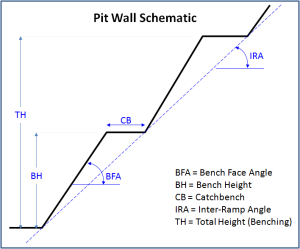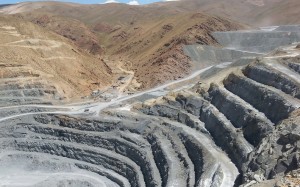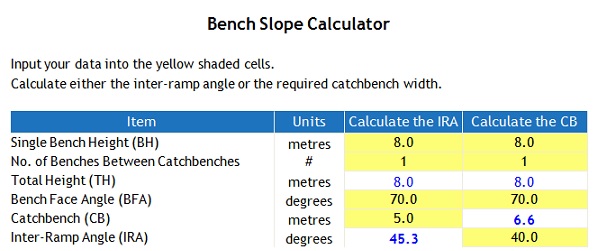
The wall of an open pit wall will consist of a series of stacked benches. Geotechnical engineers will normally provide the pit slope design criteria based on the inter-ramp angle (“IRA”) for various sectors around the pit. The IRA represents the toe-to-toe slope angle, as shown in the diagram below.
The inter-ramp angle can be created in many ways, depending on the bench height (“BH”), bench face angle, and the catch bench or berm width. Different combinations of these can be used to develop the same inter-ramp angle.
Typically the bench face angle (“BFA”) will be dictated by the rock strength, the structural fabric, and whether controlled blasting is used (minimizing damage to the walls). The BFA may vary around the pit or in different rock types, but it typically is in the range of 60° to 75°.
The catch bench (“CB”) or berm is used to catch spalling rock and prevent it from rolling down the pit wall, creating a safety hazard.
A rule of thumb is that the catch bench width should be according to the formula 4.5m + 0.2H, where H is the height of the bench. This means the recommended catch bench width for a 5m high bench should be about 5.5m; for a 10m high bench it should be 6.5m; and for 15m high bench it should be 7.5 metres.
Double benching (or triple benching) is used where the inter-ramp slopes angles are steep enough that single benching would result in an overly flatten slope.
For example if the inter-ramp slope is 50° and the BFA is 70°, then the corresponding calculated catch bench width for a 5m high bench would be 2.4 metres. However such a small catch bench would be ineffective in catching spalliing rock.
If one double benched (i.e. left a catch bench every 10m instead of every 5m), then the calculated catch bench width would be 4.8 metres. If one triple benched (i.e. left a catch bench every 15m), then the recommended width would be 7.1 metres. Hence triple benching would be suggested in this case, assuming the rock mass is of sufficient strength to sustain a 15m high face.
A simple interactive calculator (Bench Slope Calculator) has been prepared to show the relationship between all of these factors. A screenshot of the calculator is shown below. It allows one either to calculate the IRA given a set of bench height, BFA, and catch bench criteria; or calculate the catch bench width given the height, BFA, and IRA criteria. The yellow shaded cells represent input cells.
Single Bench Height (BH): this is the input height of a single operating bench.
No. of Benches between catch benches: this is the input for single, double, or triple benching.
Total Height (TH): this is the calculated total height (# of benches X single bench height)
Bench Face Angle (BFA): this is the input bench face angle, in degrees
Catch bench (CB): this is the width of the catch bench, either as an input or a calculated value.
Inter-Ramp Angle (IRA): this is the slope angle in degrees, either as a calculated value or an input.
When double or triple benching, sometimes a small 1-2m drill berm may be left between benches due to the inability of the drill to position itself against the pit wall. The width of the drill berm can possibly be eliminated by drilling the entire double bench or using smaller drills.
Sometimes one may see the term “geotechnical berm”. In some pit designs a large bench is introduced periodically, e.g. every 120m-180m in continous wall height, which acts as another measure to catch ravelling rock.
Conclusion





Excellent staff!